Charlotte artist pushes boundaries with her sculpture. And a flamethrower.
For her 28th birthday recently, Nadia Meadows only wanted one thing: a flamethrower.
An unusual gift request for most people. But for Meadows, a visual artist who learned to harness its heat as a fine arts major at UNC Charlotte, it’s perfect. She’ll use it to continue creating sculptures that capture attention, push boundaries and inspire conversations.
And now her work will find an even larger audience. Meadows recently was awarded a competitive South Arts’ State Fellowship for Visual Arts. Her “out-of-the-box approach” is one factor the jury noted in her selection.
In her artwork, Meadows designs experiences that engage the senses in unexpected ways to raise awareness on issues she finds meaningful or in need of attention. That includes social expectations around hair, particularly regarding African American hair styles, overturning Roe v. Wade and child abuse.
Her art, she said, is a reaction to when something bothers her.
She often uses unusual materials, including burnt wood, concrete and even human hair. Meadows manipulates space in surprising ways, too.
Her sculptures are often big, sometimes suspended from above or positioned where viewers have no choice but to walk on top of them. Meadows’ work has frequently been exhibited around Charlotte, including at Mint Museum Uptown, Nine Eighteen Nine Studio, Charlotte SHOUT! and the recent Durag Festival.
According to a South Arts representative, the jury commended Meadows’ “strong body of work, her use of diverse processes and materials and a clearly researched subject matter that speaks to... the lived experiences of many people who navigate discrimination, conformity to societal norms and a lack of understanding.”
Meadows is the only artist from North Carolina who is receiving the annual award. All nine fellows come from states across the South.
As the North Carolina State Fellow, Meadows will receive $5,000. Her work also will be featured along with the other state fellows at an exhibition hosted by the Ohr-O’Keefe Museum in Biloxi, Mississippi, from Aug. 17 to Dec. 13. The exhibit will tour across the South in 2024.
Meadows also is in the running for the $25,000 Southern Prize for Visual Arts, or the finalist award of $10,000. Winners will be announced in August at the exhibition opening in Biloxi.
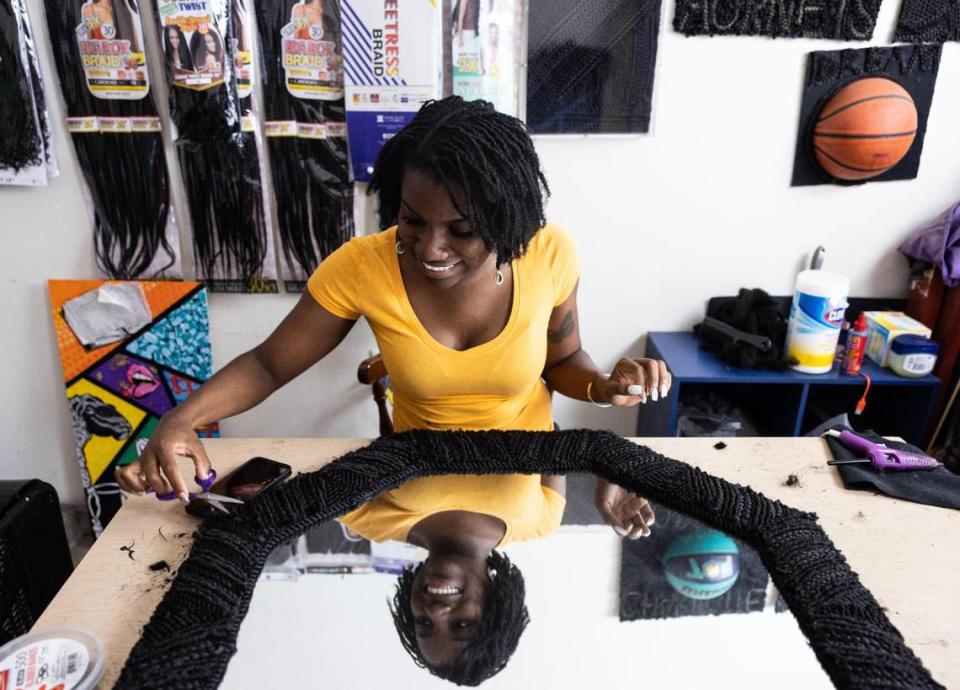
Changing kids’ perceptions?
Meadows plans to use the money to design models for a potential public art project.
The concept is a playground that incorporates giant hair-care implements turned play-things. It also includes positive words of affirmation and acceptance to reinforce the message that everyone is beautiful with the hair they have and however they wear it.
Her goal is to change the way that children, especially Black kids, perceive themselves and others.
“All of the pieces of the playground are gonna be hair themed,” Meadows said. Objects include “a brush that people can fly down, a flat iron that is also a slide, swings that you can swing between the… teeth of the hot comb.”
The playground is inspired by her own experiences as well as stories she’s gathered from others. It’s a theme she has been exploring with many of her recent art works.
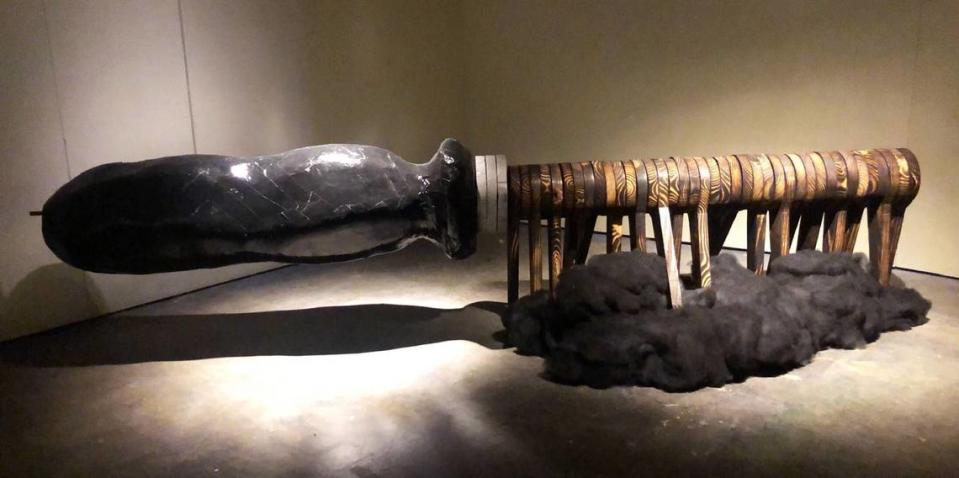
Challenging people on how they think about art
The idea for using hair not only as a subject but as an integral component of Meadows’ artwork came partly from necessity.
“In 2020 everything shut down because of COVID,” she said, “and a lot of the studios at school were down so I had to work out of my apartment.”
Wood-making and large-scale clay projects were impossible from home so Meadows had to get creative. She realized the beauty supply store remained open. So she decided to incorporate what was readily available there to make a big statement for her final piece at UNC Charlotte while she was working towards her BFA.
The resulting sculpture was “Subtle Oppression,” a series of panels made from natural braiding hair and twists.
Each panel incorporates symbols related to African American culture. It includes historical references like the “Shoofly” and “Crossroad,” symbols. Meadows said these images were woven into women’s hair during the Underground Railroad to guide enslaved people on their journey North.
She also included contemporary images related to issues like gentrification and disparities in public school funding. There are specific references, too, such as a graduation cap, inspired by a news report about a young man who was obliged to cut his locs in order for the standard cap to fit.
The work is designed to be displayed on the floor at the front of a gallery so viewers have to interact and respond to it.
Meadows knows it makes people uncomfortable to contemplate walking on a work of art and particularly one made of real African-American hair.
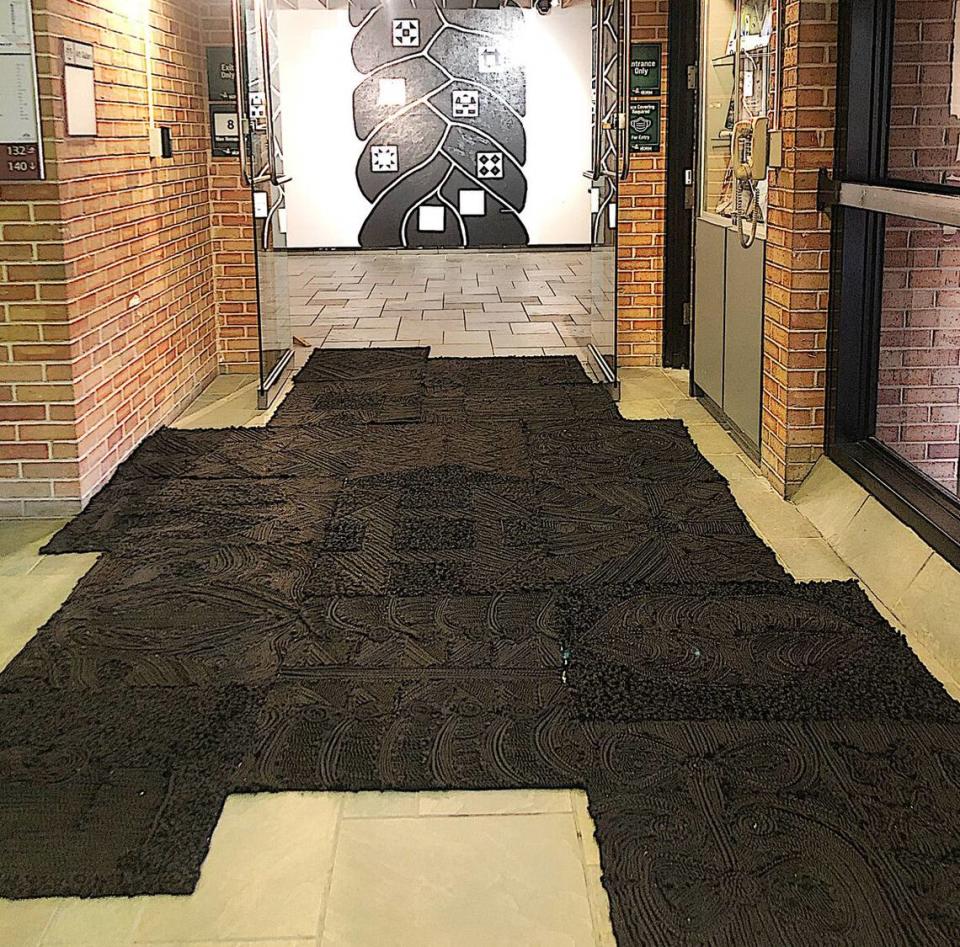
“Making a statement and putting people a little off guard is kind of the type of art that I like to do,” she said.
She wants viewers to question how they interact in a gallery space and challenge them to think more deeply about the work.
“Not just, ‘oh that’s kind of nice’ or ‘Um, I wonder what that meant?’ “ she said, “but having an interaction where you can touch it, walk on it, feel it… and have a conversation.”
Exhibiting a work of art on the floor means that it also gets worn down over time, Meadows said, even though people are reluctant to walk on it. That erosion is something she repairs periodically and partially. But it’s also meant to be symbolic of the long term consequences of harmful speech.
“So maybe one comment doesn’t really hurt,” Meadows said, “...or one person walking on it doesn’t really hurt the piece. But when you think about a whole year of people commenting on your hair or speaking to you in a way that is not very comfortable… over time, they slowly degrade like the panels.”
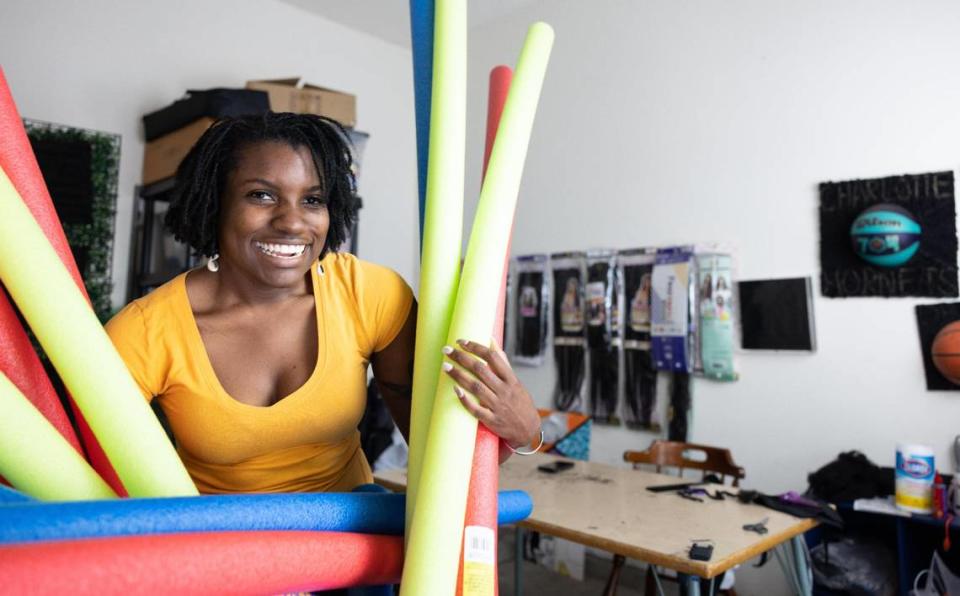
Other inspirations for Nadia Meadows
Meadows creates works that bring attention to topics that she thinks are overlooked.
One recent project, “Enslaved,” includes what appears to be the female symbol suspended from the ceiling. A constricting metal chain wraps around it and descends to a replica of the state of North Carolina on the floor.
“Chained to the state we live in is the feeling I had at news of Roe V. Wade being overturned,” reads an artist statement from Meadows on the South Arts website. “This sculpture acknowledges all women and the uncertainty of this new ruling.”
In another work, “Little Black Girl,” she focuses on violence and abuse directed at children.
Created for “Unbound,” a recent exhibition about sexual abuse and violence, and hosted by the Charlotte Art League, her piece was inspired by the many hair stories she’s heard, which she said often reveal other forms of trauma.
“We hit a whole lot about gun violence and school shootings... but there’s also a lot of other very tragic, very impactful things that are going on in people’s lives that are not necessarily talked about in the media.”
Meadows said she always has processed her feelings through art, but used to hide her more personal creations from others.
She became more confident, open and vulnerable in her sculptures, thanks to her experience at UNC Charlotte and a residency at Goodyear Arts, a non-profit artist-led Charlotte studio and exhibition space.
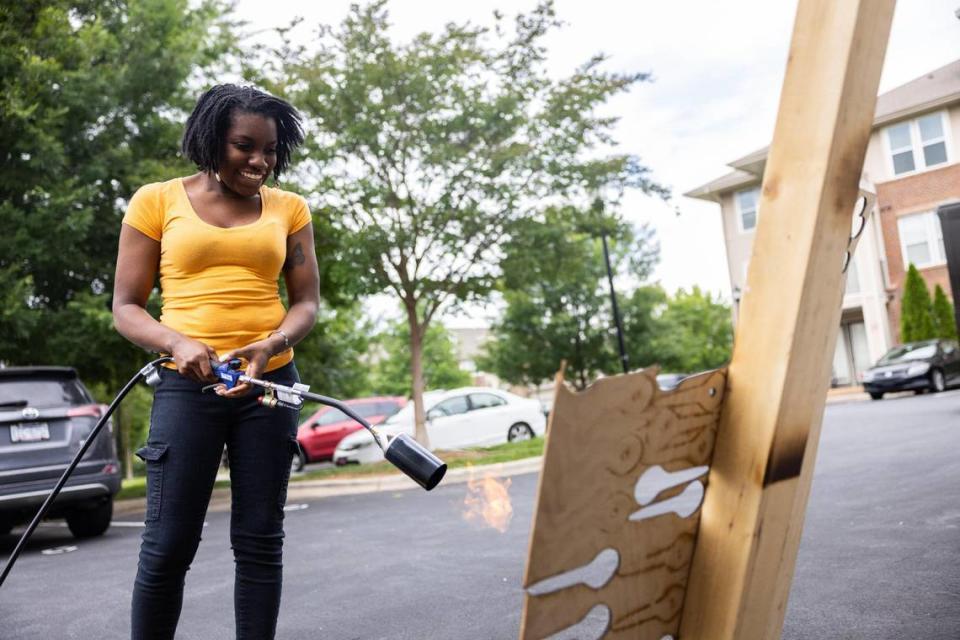
Meadows became accustomed to critiques and responding to many questions about her work, even when it’s a tough subject.
“I’m okay now with expressing what I was feeling in that moment of making it,” she said. “And most of the time, the action of making it is the therapy… and seeing how people relate to it it’s always a bonus on top of the act of making.”
One more thing.
At 4’11”, Meadows said she has always felt small in comparison to the world around her. “I’m not always noticed,” she said. So her goal is to create artwork that is larger than life and unmissable.
“I try to make it as big as possible,” Meadows said, “so you can’t just walk past.”
More about Nadia Meadows
Find out more about Meadows’ work and upcoming events at her website: nadiameadows.com or on Instagram @art__bynadiameadows.
More arts coverage
Want to see more stories like this? Sign up here for our free “Inside Charlotte Arts” newsletter: charlotteobserver.com/newsletters. And you can join our Facebook group, “Inside Charlotte Arts,” by going here: facebook.com/groups/insidecharlottearts.

